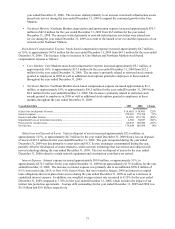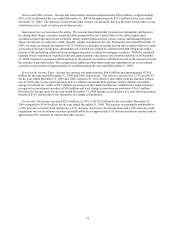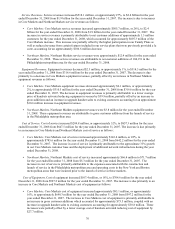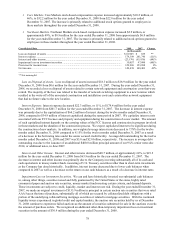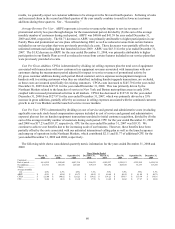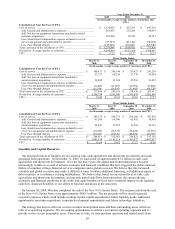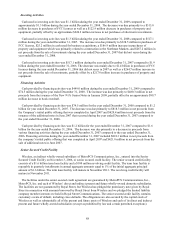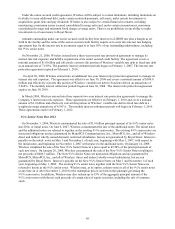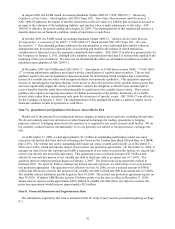Metro PCS 2009 Annual Report Download - page 95
Download and view the complete annual report
Please find page 95 of the 2009 Metro PCS annual report below. You can navigate through the pages in the report by either clicking on the pages listed below, or by using the keyword search tool below to find specific information within the annual report.
83
Average number of customers for any measurement period is determined by dividing (a) the sum of the average
monthly number of customers for the measurement period by (b) the number of months in such period. Average
monthly number of customers for any month represents the sum of the number of customers on the first day of the
month and the last day of the month divided by two. ARPU for the year ended December 31, 2009 includes
approximately $42.9 million that would have been recognized as service revenues but were classified as equipment
revenues because the consideration received from customers was less than the fair value of promotionally priced
handsets. The following table shows the calculation of ARPU for the periods indicated.
Year Ended December 31,
2009 2008 2007
(In thousands, except average number of customers and
ARPU)
Calculation of Average Revenue Per User
(ARPU):
Service revenues................................................................................... $ 3,130,385 $ 2,437,250 $ 1,919,197
Add:
Impact to service revenues of promotional activity ........................... 42,931 — —
Less:
Pass through charges.......................................................................... (173,099) (136,801) (95,946)
Net service revenues ............................................................................. $ 3,000,217 $ 2,300,449 $ 1,823,251
Divided by: Average number of customers .......................................... 6,145,414 4,631,168 3,508,497
ARPU ................................................................................................... $ 40.68 $ 41.39 $ 43.31
Three Months Ended
March 31,
2008
June 30,
2008
September 30,
2008
December 31,
2008
(In thousands, except average number of customers and ARPU)
Calculation of Average Revenue Per User (ARPU):
Service revenues....................................................................... $ 561,970 $ 598,562 $ 610,691 $ 666,028
Less:
Pass through charges.............................................................. (26,554) (30,583) (31,445) (48,220)
Net service revenues ................................................................. $ 535,416 $ 567,979 $ 579,246 $ 617,808
Divided by: Average number of customers .............................. 4,198,794 4,501,980 4,741,043 5,082,856
ARPU ....................................................................................... $ 42.51 $ 42.05 $ 40.73 $ 40.52
Three Months Ended
March 31,
2009
June 30,
2009
September 30,
2009
December 31,
2009
(In thousands, except average number of customers and ARPU)
Calculation of Average Revenue Per User (ARPU):
Service revenues....................................................................... $ 726,698 $ 766,850 $ 812,340 $ 824,498
Add:
Impact to service revenues of promotional activity ............... — 24,728 12,481 5,721
Less:
Pass through charges.............................................................. (37,643) (39,641) (48,030) (47,785)
Net service revenues ................................................................. $ 689,055 $ 751,937 $ 776,791 $ 782,434
Divided by: Average number of customers .............................. 5,685,830 6,185,166 6,303,075 6,407,637
ARPU ....................................................................................... $ 40.40 $ 40.52 $ 41.08 $ 40.70
CPGA — We utilize CPGA to assess the efficiency of our distribution strategy, validate the initial capital
invested in our customers and determine the number of months to recover our customer acquisition costs. This
measure also allows us to compare our average acquisition costs per new customer to those of other wireless
broadband mobile providers. Equipment revenues related to new customers, adjusted for the impact to service
revenues of promotional activity, are deducted from selling expenses in this calculation as they represent amounts
paid by customers at the time their service is activated that reduce our acquisition cost of those customers.
Additionally, equipment costs associated with existing customers, net of related revenues, are excluded as this
measure is intended to reflect only the acquisition costs related to new customers. The following table reconciles
total costs used in the calculation of CPGA to selling expenses, which we consider to be the most directly
comparable GAAP financial measure to CPGA.


